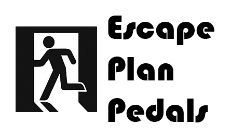Acid Etching - The Story Behind the Artwork on Escape Plan Pedals August 03 2014
When I first started building pedals, I experimented with a few different methods for adding color or artwork to the boxes. First, I tried hammertone spray paint, which turned out less than stellar. That is, until I hit it with lacquer for a protective clear coat layer. Even though the hammertone was dried and cured in an oven, the lacquer caused the hammertone paint to crinkle and take on a tolex-like finish, which was actually quite cool. I still have a green octave fuzz pedal in my collection finished in this style. Needless to say, I didn't feel the results would be easy to replicate every time, so I decided to explore other options.
Since I was already etching my own PCBs off and on, I started researching to see if anyone had tried using the same method to etch the outside of the aluminum enclosure. I stumbled upon a few guys on discussion boards that were using various methods to apply an etching mask to enclosures and various etchants to etch the design into the box. After seeing the successes and failures many others had experienced, I decided to give the process a try myself, mixing many of the different documented processes to come up with the variation that worked best for me.
I start with a bare aluminum enclosure and sand it until the top surface is smooth and the majority of imperfections have been removed. Then the enclosure is cleaned and prepared for transferring of the etch mask (a photo negative of the image to be etched). Once the transfer is complete, any imperfections in the mask are repaired and the box is masked and ready to be etched.
After a short time in a shallow acid bath, the enclosure is removed and the mask and residue from the etching process is cleaned off the box. The box is then scrubbed with a brass bristle brush to remove any remaining oxidation from the etching process, and the box is masked again and prepared to be painted. We use a high quality, high temperature engine enamel to paint our boxes, then cure them in an oven.
Once the box cools, we sand the excess paint, leaving the design visible in the reliefs from the etching process. The boxes are then drilled to allow for switches, jacks, and controls. The box is then cleaned again and a high quality automotive clear coat is applied to the box before it takes another trip through the oven for its final curing process.

From start to finish, this process is done by hand. The sanding, the transferring, the etching...all of it. If the design of the circuits inside is half art and half science, the finishing of the enclosure is closer to pure art (discounting the little bit of chemistry). Due to this, NO TWO PEDALS ENCLOSURES WILL LOOK EXACTLY THE SAME. I think of this being like when you look at two guitars with transparent finishes of the same model and you see subtle variations in the wood grain, differences in the finish in spots, etc. You can be certain that your pedal from Escape Plan Pedals is a one of a kind, and this is doubly so if you decide to spring for custom artwork.
Is it time consuming? Yes. Very. We believe that every pedal that leaves our door is a testament to the sore arms, tired backs, and strained eyes that it took to get that pedal on your board. And if a striking exterior gets you to give our pedals a try and fall in love with the tones they produce, then it was all worth it.


